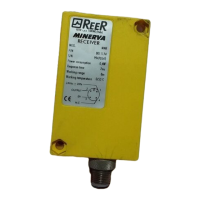3
GENERAL
MINERVA is a barrier type photocell consisting of a separate emitter and receiver. When
it is connected to the standard control units AU S3, AU S-TWIN or the integrated unit
with muting function AU S3M2, MINERVA represents a type 2 safety system for the
protection against accidents of people exposed to hazards on dangerous machinery. The
commutation of the control unit output relays, which is triggered when the beam meets
an obstacle, makes it possible to stop industrial machinery with moving parts, such as:
• Handling, pallet loading/unloading systems;
• Assembly lines;
• Automated industrial warehouses;
• Robotised areas.
Its protection function is not sufficient in the following circumstances:
!
The control unit of a machine cannot be controlled electrically or is unable to stop
hazardous movements promptly and at any time during the work cycle.
!
The hazard condition is associated with the risk of items falling from above or being
ejected from the machine.
!
For applications in the food processing industry, contact the manufacturer to determine the
compatibility between the materials of the photocell and the chemical agents employed.
!
For all matters to do with safety, if necessary, seek advice from the authorities in charge of
safety problems in your country, or the cognisant industrialists association.
OPERATION
The MINERVA safety system may consist of one or two emitter/receiver pairs connected
to a control unit. This system is able to detect the passage of a person’s entire body and
cannot be used for the protection of arms and hands. Whenever the optical path of the
beam linking the emitter to the receiver is fully interrupted, the receiver discontinues the
transmission of the output signal.
Upon recognising this condition, the control unit immediately de-energises its outputs
and prevents a dangerous condition from coming into being.
When the beam is released, system re-start depends on the positive output of the test
function. The test is performed as follows:
• a command from the control unit turns off the emitter;
• the receiver detects the interruption of the radius and cuts off the output signal:
• the control unit verifies the conformity to the reaction time of the receiver, its outputs
and the external relays (K1- K2), if any.
This test is controlled from the outside, thanks to the closing of a button.

